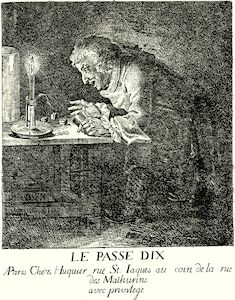Passage
Last updated: .
Passage is an old dice gambling game for two players.A (p. 167) In French it was called passe-dix ‘pass-ten’, similarly in Italian passadiéci,B (360) and in German Paschen. It has also been called ‘pass-dice’.C (45)

Le Passe Dix (c. 1797) by Daniel Nikolaus Chodowiecki (here signed ‘Huquier’, the publishing address is also false). The player is probably the button-maker Nicolas Fonvielle.D (p. 38)
In England, the game was specifically outlawed by the Gaming Act 1739 (previously known as 13 Geo. II., c. 19), which was a new addition since the Gaming Act 1738 (12 Geo. II., c. 28) of the previous year:
And whereas a good and wholesome law was made in the twelfth year of the reign of His present Majesty King George the Second, intituled “An Act for the more effectual Preventing of excessive and deceitful Gaming;” but, contrary to the true intent and meaning thereof, some fraudulent and deceitful games have been invented, and a certain game called “passage” is now daily practised and carried on, to the Ruin and impoverishment of many of His Majesty’s subjects :
The said game of passage, and all and every other game and games invented or to be invented with one or more die or dice, or with any other instrument, engine, or device in the nature of dice, having one or more figures or numbers thereon (back-gammon and the other games now played with the backgammon tables only excepted), are and shall be deemed to be games or lotteries by dice, within the intent and meaning of the said in part recited Act : […]
Francis Grose, in A Classical Dictionary of the Vulgar Tongue, indicates that by 1785 Passage was a “camp game” played amongst soldiers, and that the person in charge of running the game throughout the army was called the “head cully of the pass” or the “passage bank”.
The game is mentioned in The Three Musketeers (1844),F (p. 133) where Porthos plays it with some young clerks.Alongside bassette and lansquenet. The game also appears in later editions of Rabelais’ Gargantua, at least from 1884.
Play
On a player’s turn they place a bet and roll three dice until they roll a double. If the sum of the dice is above ten, then they pass and win, otherwise they are out and lose.
The odds of rolling a double on three dice are 96⁄216; of those 96 valid rolls, 48 total above ten, thus the game is fair (48⁄96 = 1⁄2). Winning stakes are paid out 1∶1 and so the house has no advantage.
The inclusion of the double requirement only serves to heighten the tension of the game, as the results are the same without it (the odds of rolling above ten on three dice are 108⁄216 = 1⁄2).
Hombas (2012) gives a generalization of this game to any number of dice, by calculating the “pass points” for each number. Note that this calculation ignores the doubles-requirement, which may alter the game for numbers of dice other than three.
Dice | Pass point |
|---|---|
1 | 2 |
2 | 7 |
3 | 10 |
4 | 14 |
5 | 17 |
6 | 21 |
7 | 24 |
8 | 28 |
References
Cotton, Charles (). The Compleat Gameſter. A. M.: London.
Florio, John [Giovanni Florio] (). Queen Anna’s New World of Words, or Dictionarie of the Italian and English Tongues. Edward Blount and William Barret: London.
G. Allen (). Annals of Gaming; or, the Fair Player’s Sure Guide. G. Allen: London.
van der Lely – van der Steur, Arine and Anna Bianco (). Catalogus 44: Antique Games [archived]. Antiquariaat Arine van der Steur: The Hague, The Netherlands.
Grose, Francis (). A Classical Dictionary of the Vulgar Tongue. S. Hooper: London.
Dumas, Alexandre (). Les Trois Mousquetaires [text in French] volume 3. Baudry: Paris.
Huyn, P. N. (). La Theorie des Jeux de Hasard [text in French].
Hombas, Vassilios (). ‘Generalizing Galileo’s passé-dix game’. International Journal of Mathematical Education in Science and Technology vol. 43 (5), : pages 643–702. doi:10.1080/0020739X.2011.618549.